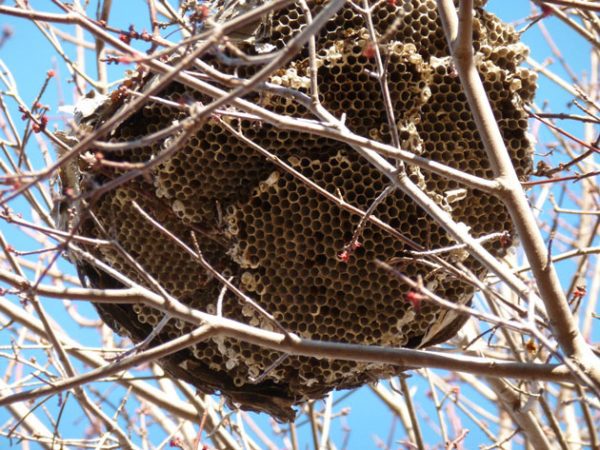Bald-faced hornets – master builders

Last fall, as the trees surrendered their leaves, I discovered four large hornets’ nests along my regular mile-long route through Atlanta’s Piedmont Park. Despite passing within a few feet of them on an almost daily basis throughout the spring and summer, the hornets had never given me a bit of trouble. The bald-faced hornet (Dolichovespula maculata) has a reputation for being much less aggressive than its ornery cousin, the yellowjacket.
Perhaps these small black and white wasps are too intent on building their intricate nests. They craft the papery gray orbs – often larger than a football or basketball – from a mix of chewed wood fiber and saliva. This monumental effort begins in spring when a queen lays an egg in a single cell then stocks it with insects and nectar to feed the larva. She repeats this process countless times. The larvae mature into female workers. They expand the nest while the queen continues laying eggs. Males appear toward the end of summer, after most of the work is done (demonstrating an uncanny resemblance to the species known as Homo sapiens). They don’t even sting. Their only role is to fertilize some of the females. The future queens leave the nest to hibernate alone, generally under tree bark or in an old stump. They emerge in spring, the only survivors of the colony. The abandoned nests deteriorate, eventually succumbing to the elements and wildlife predation.
Several years ago, Dad noticed a nest dangling from a sapling near Eleazer Church.He kept an eye on it during his daily walks along the dirt road. It remained intact deep into the winter. When he felt certain it had been subjected to enough cold weather to kill off all the inhabitants, he, my sister and her kids went to collect it. They bent the sapling and cut the branch where the nest was attached. Even though there was no evidence of live hornets, they left the nest in a shed for several months. This allows any remaining carcasses or larvae to dry up, preventing objectionable odors once it’s brought indoors. If a nest is collected early in the season and there’s a chance some hornets might still be alive, it can be wrapped in a plastic bag and placed overnigt in a freezer. Some people recommend preserving the nest with hairspray, but the one from the Uwharries has graced my sister’s living room mantle for several years without any special treatment.

Bald-faced hornets are a food source for a number of species. They also prey upon other insects, including those hateful yellowjackets, which ought to give us plenty of incentive to co-exist with them if possible. That said, they can become extremely aggressive if their nest is disturbed. This can prove fatal for anyone highly allergic to stings. Nests in high-traffic areas might warrant removal. In summer, this can be treacherous and is probably best left to a professional, but for people who want to do it themselves, there are ways to reduce the risk of being stung.
According to the N.C. Cooperative Extension Service, it’s best to approach this task at dusk. Wear protective gear such as a bee suit if possible. Stand at least 10-12 feet away and spray an insecticide especially formulated for wasps and hornets into the opening. Do not use gasoline. Quickly move away from the area in case any hornets emerge from the nest. Do not carry a flashlight or have any other light source in the vicinity, as it might attract the insects. Additional treatments might be required on subsequent evenings. With any luck, the nest will remain intact, providing a conversation piece for the living room and inspiring an appreciation of our natural world for many years to come.